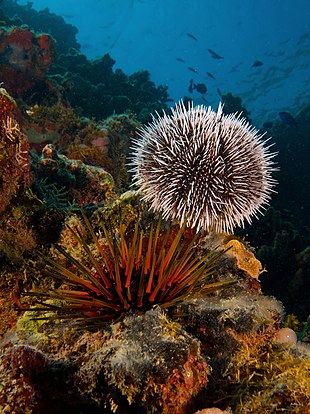Talk:Sea urchin
| This is the talk page for discussing improvements to the Sea urchin article. This is not a forum for general discussion of the article's subject. |
Article policies
|
| Find sources: Google (books · news · scholar · free images · WP refs) · FENS · JSTOR · TWL |
| Archives: 1 |
Daily pageviews of this article
A graph should have been displayed here but graphs are temporarily disabled. Until they are enabled again, visit the interactive graph at pageviews.wmcloud.org |
| Sea urchin has been listed as one of the Natural sciences good articles under the good article criteria. If you can improve it further, please do so. If it no longer meets these criteria, you can reassess it. | ||||||||||
| ||||||||||
A fact from this article appeared on Wikipedia's Main Page in the "Did you know?" column on June 19, 2018. The text of the entry was: Did you know ... that sea urchins can go bald? | ||||||||||
| This It is of interest to the following WikiProjects: | |||||||||||||||||||||||||||||||||||||||||||||
| |||||||||||||||||||||||||||||||||||||||||||||
There is a request, submitted by Catfurball, for an audio version of this article to be created. For further information, see WikiProject Spoken Wikipedia. The rationale behind the request is: "Important". |
animals that eat urchins in lead Too regional[edit]
The lead lists sea otters, wolf eels and triggerfish as Main predators Of sea urchin. I’m pretty sure this was sourced from somewhere talking only about sea urchins in the northeast pacific probably California. Since this is the article on urchins as a whole not just the those on the west coast of North America I’m going to loosen the language a bit 75.142.22.164 (talk) 19:44, 18 August 2022 (UTC)
Sea urchin[edit]
characteristic 103.167.233.7 (talk) 01:34, 1 December 2022 (UTC)
Musclo-skelatal intro paragraph is too "chummy"[edit]
The first paragraph is very chatty and not well written
> Sea urchins might appear to be incapable of moving but this is a false impression. [Really? you're assuming a lot about what I think] In some cases, [which cases specifically are you talking about and which are you not?] the most visible sign of life is the spines, which are attached to ball-and-socket joints [they are NOT ball and socket joints] and can point in any direction; in most urchins, touch elicits a prompt reaction from the spines, which converge toward the touched point. [this is NOT related to them moving, but is more a defence mechanism - so put it in a different paragraph.] Sea urchins have no visible eyes, legs, or means of propulsion, [chatty, do they have invisible eyes?] but can move freely but slowly over hard surfaces using adhesive tube feet, working in conjunction with the spines. [is this not a means of propulsion?]
Some of the spines are 6 inches long. Do you mean to say that the tube-feet can extend that long to reach past the spines and move the urchin? Lehasa (talk) 15:40, 28 December 2022 (UTC)
- I've fixed it up now.
- Various resources I've found are listed below. Perhaps they'll be useful for anyone who wants to improve things more.
- http://www.chalk.discoveringfossils.co.uk/CIDAROID_terminology.htm
- https://ns-echinodermata.linnaeus.naturalis.nl/linnaeus_ng/app/views/introduction/topic.php?id=2845
- https://cronodon.com/BioTech/echinoids.html
- http://animaldiversity.org/site/accounts/information/Echinoidea.html
- https://www.nhm.ac.uk/our-science/data/echinoid-directory/morphology/regulars/intro.html Lehasa (talk) 20:23, 28 December 2022 (UTC)
female sea urchins[edit]
Reproduction only talks about male sea urchins. What about females? It does say there are clear male female sea urchins. Cowcatmom (talk) 17:13, 21 August 2023 (UTC)
Featured picture scheduled for POTD[edit]
Hello! This is to let editors know that File:Tripneustes ventricosus_(West_Indian_Sea_Egg-top)_and_Echinometra_viridis_(Reef_Urchin_-_bottom).jpg, a featured picture used in this article, has been selected as the English Wikipedia's picture of the day (POTD) for May 18, 2024. A preview of the POTD is displayed below and can be edited at Template:POTD/2024-05-18. For the greater benefit of readers, any potential improvements or maintenance that could benefit the quality of this article should be done before its scheduled appearance on the Main Page. If you have any concerns, please place a message at Wikipedia talk:Picture of the day. Thank you! — Amakuru (talk) 17:02, 10 May 2024 (UTC)

|
Sea urchins are a group of spiny globular echinoderms which form the class Echinoidea. About 950 species live on the seabed, inhabiting all oceans and depth zones from the intertidal to 5,000 metres (16,000 ft; 2,700 fathoms). Their tests (hard shells) are round and spiny, typically from 3 to 10 cm (1 to 4 in) across. Sea urchins move slowly, crawling with their tube feet, and sometimes pushing themselves with their spines. They feed primarily on algae but also eat slow-moving or sessile animals. Their predators include sea otters, starfish, wolf eels, and triggerfish. This photograph shows a West Indian sea-egg (top) and a reef urchin (bottom), off the northern coast of Haiti close to Cap-Haïtien. Photograph credit: Nick Hobgood
Recently featured:
|
- Wikipedia good articles
- Natural sciences good articles
- Wikipedia Did you know articles that are good articles
- GA-Class vital articles
- Wikipedia level-4 vital articles
- Wikipedia vital articles in Biology and health sciences
- GA-Class level-4 vital articles
- Wikipedia level-4 vital articles in Biology and health sciences
- GA-Class vital articles in Biology and health sciences
- GA-Class Fishing articles
- High-importance Fishing articles
- WikiProject Fishing articles
- GA-Class animal articles
- Low-importance animal articles
- WikiProject Animals articles
- GA-Class Marine life articles
- High-importance Marine life articles
- WikiProject Marine life articles
- Spoken Wikipedia requests



